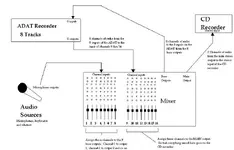To elaborate
To elaborate a little...
Consider the mixer (also commonly refered to as a "console", "desk", or "board") the "traffic cop" of the studio. It tells stuff where to go. (Sorry Muttley, but I have to disagree with the "central control device" analogy as it implies much more functionality and wvsoulja appears to be new to the wonderful world of audio. That would probably make it more confusing than it needs to be right now) It takes signals from the performers (microphones, etc...) and tells them where to go (multi-track recorder which, with the exception of some all-in-one boxes, is a seperate unit). Then when you mix (combine all of your individually recorded instruments into a unified piece... for instance to a CD) it takes the signals from the recorder and allows you to manipulate the volume of each channel (intstrument/source... for instance it is not uncommon to see 10 or more tracks of different drums... 1 for kick, 1 for snare, and so on) change the equalization of each channel (depending on the console it may be simple or elaborate), send that signal to other gear in the studio for further prossesing (ie reverb and other processing gear), and in higher end consoles compression and gating (both of which are dynamic processes).
Most decent boards give you several options for sending signal out of and recieving signal into it allowing you to inter-connect gear more easily and in different configurations. They also (again in anything that is at least decent) have outputs for control room monitoring and sometimes headphone outputs.
I'm not quite sure what you are asking when you say:
"Can you make all vocals 1 solid dB with them, so that there is no lows or high?"
But....
dB's refer to signal strength (generally associated with volume) and lows and highs are an EQ thing. If you are asking if you can change the tonal characteristics of your vocals (lows and highs) AND set all of your vocals to be at the same volume, then the answer is yes, but they are 2 seperate things.
Like I said earlier, you sound like you are new to audio, so this is a great place to start learning the basics and concepts. There are a ton of books out there too. For instance "Modern Recording Techniques" by David Huber (and someone else, but I can't remember his name...)
I'm glad to offer my knowledge if you have any other questions (such as multi-track recorders and other stuff like that). I'll keep an eye on this board or feel free to email me if you like at
audiobond@aol.com.
Sorry about the long post! If this isn't clear, let me know and I'll try another approach.
Later
-Chris

 A mixer is used for bringing in all your vocals(mics), instruments(direct in,mic'ed cabnets,mic'ed direct) And directing signal to the band(monitoring), recording device. Then its used for bringing the signal from recording device and building a mix to usually a stereo.
A mixer is used for bringing in all your vocals(mics), instruments(direct in,mic'ed cabnets,mic'ed direct) And directing signal to the band(monitoring), recording device. Then its used for bringing the signal from recording device and building a mix to usually a stereo. )
) Another good way to learn about audio eqpt. is read all the catalogues you can, they give accurate descriptions of all the toys, tools, techniques, and technologies. This was one starting point for me.
Another good way to learn about audio eqpt. is read all the catalogues you can, they give accurate descriptions of all the toys, tools, techniques, and technologies. This was one starting point for me.